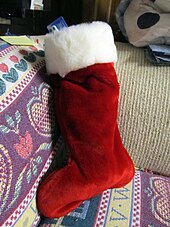
Father Christmas is the traditional English name for the personification of Christmas. Although now known as a Christmas gift-bringer, and typically considered to be synonymous with Santa Claus, he was originally part of a much older and unrelated English folkloric tradition. The recognisably modern figure of the English Father Christmas developed in the late Victorian period, but Christmas had been personified for centuries before then.

Saint Nicholas of Myra, also known as Nicholas of Bari, was an early Christian bishop of Greek descent from the maritime city of Patara in Anatolia during the time of the Roman Empire. Because of the many miracles attributed to his intercession, he is also known as Nicholas the Wonderworker. Saint Nicholas is the patron saint of sailors, merchants, archers, repentant thieves, children, brewers, pawnbrokers, toymakers, unmarried people, and students in various cities and countries around Europe. His reputation evolved among the pious, as was common for early Christian saints, and his legendary habit of secret gift-giving gave rise to the folklore of Santa Claus through Sinterklaas.

"A Visit from St. Nicholas", routinely referred to as "The Night Before Christmas" and "'Twas the Night Before Christmas" from its first line, is a poem first published anonymously under the title "Account of a Visit from St. Nicholas" in 1823. Authorship has been attributed to Clement Clarke Moore, who claimed authorship in 1837, but it has also been suggested that Henry Livingston Jr. may have written it.
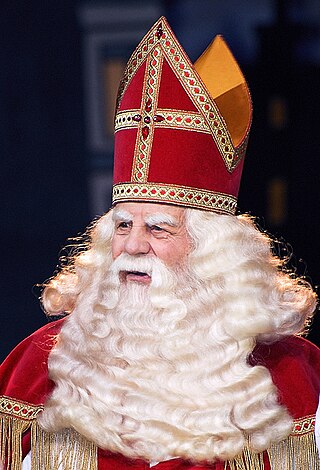
Sinterklaas or Sint-Nicolaas is a legendary figure based on Saint Nicholas, patron saint of children. Other Dutch names for the figure include De Sint, De Goede Sint and De Goedheiligman. Many descendants and cognates of "Sinterklaas" or "Saint Nicholas" in other languages are also used in the Low Countries, nearby regions, and former Dutch colonies.
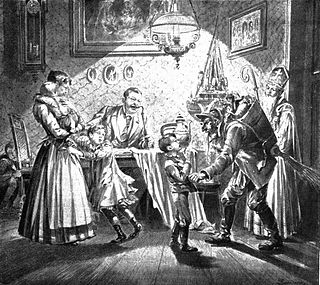
The companions of Saint Nicholas are a group of closely related figures who accompany Saint Nicholas throughout the territories formerly in the Holy Roman Empire or the countries that it influenced culturally. These characters act as a foil to the benevolent Christmas gift-bringer, threatening to thrash or abduct disobedient children. Jacob Grimm associated this character with the pre-Christian house spirit which could be benevolent or malicious, but whose mischievous side was emphasized after Christianization. The association of the Christmas gift-bringer with elves has parallels in English and Scandinavian folklore, and is ultimately and remotely connected to the Christmas elf in modern American folklore.

Saint Nicholas Day, also called the "Feast of Saint Nicholas", observed on 6 December in Western Christian countries, and on 19 December in Eastern Christian countries using the old church Calendar, is the feast day of Saint Nicholas of Myra; it falls within the season of Advent. It is celebrated as a Christian festival with particular regard to Saint Nicholas' reputation as a bringer of gifts, as well as through the attendance of church services.

Ded Moroz, or Morozko, is a legendary figure similar to Saint Nicholas, Father Christmas, and Santa Claus who has his roots in Slavic mythology. The tradition of Ded Moroz is mostly spread in East Slavic countries and is a significant part of Russian culture. At the beginning of the Soviet era, communist authorities banned Ded Moroz. However, the ban was lifted and he soon became a significant part of Soviet culture. The literal translation of DedMoroz is Grandfather Frost or Old Man Frost, but traditionally the name is translated as Father Frost.
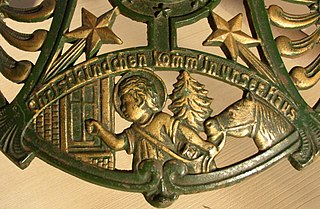
The Christkind, also called Christkindl, is the traditional Christmas gift-bringer in Austria, Switzerland, southern and western Germany, the Czech Republic, Croatia, Liechtenstein, Luxembourg, the eastern part of Belgium, Portugal, Slovakia, Hungary, parts of northeastern France, Upper Silesia in Poland, parts of Latin America, in certain areas of southern Brazil, and in the Acadiana region of Louisiana. Christkind is called in Portuguese Menino Jesus, in Hungarian Jézuska, in Slovak Ježiško, in Czech Ježíšek, in Latin America Niño Dios or Niño Jesús and in Croatian Isusić or Isusek, in Silesian Dziyciōntko Jezus, in Cieszyn Silesian Aniołek, in Polish Dzieciątko. In some parts of Italy, the analogous figure of the Christkind is known as Gesù Bambino.

A Christmas decoration is any of several types of ornamentation used at Christmas and the greater Christmas and holiday season. The traditional colors of Christmas are pine green (evergreen), snow white, and heart red. Gold and silver are also prevalent, as are other metallic colours. Typical images on Christmas decorations include Baby Jesus, Mother Mary, angels, Father Christmas, Santa Claus, and the star of Bethlehem. Advent wreaths, nativity scenes, illuminations, and Moravian stars are popular Christmas decorations.
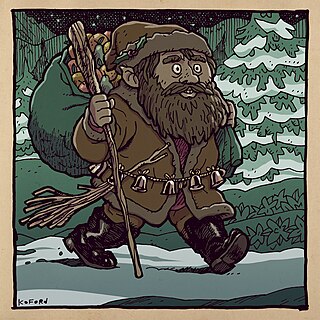
Knecht Ruprecht is a companion of Saint Nicholas as described in the folklore of Germany. He is the most popular gift-bringing character in Germany after Saint Nicholas, Christkindl, and Der Weihnachtsmann but is virtually unknown outside the country. He first appears in written sources in the 17th century, as a figure in a Nuremberg Christmas procession.

Motion pictures featuring Santa Claus constitute their own subgenre of the Christmas film genre. Early films of Santa revolve around similar simple plots of Santa's Christmas Eve visit to children. In 1897, in a short film called Santa Claus Filling Stockings, Santa Claus is simply filling stockings from his pack of toys. Another film called Santa Claus and the Children was made in 1898. A year later, a film directed by George Albert Smith titled Santa Claus was created. In this picture, Santa Claus enters the room from the fireplace and proceeds to trim the tree. He then fills the stockings that were previously hung on the mantle by the children. After walking backward and surveying his work, he suddenly darts at the fireplace and disappears up the chimney.

In traditional festive legend and popular culture, Santa Claus's reindeer are said to pull a sleigh through the night sky to help Santa Claus deliver gifts made by Christmas elves to children on Christmas Eve.

Belsnickel is a crotchety, fur-clad Christmas gift-bringer figure in the folklore of the Palatinate region of southwestern Germany along the Rhine, the Saarland, and the Odenwald area of Baden-Württemberg. The figure is also preserved in Pennsylvania Dutch communities and Brazilian-German communities.

Santa Claus is a legendary figure originating in Western Christian culture who is said to bring gifts during the late evening and overnight hours on Christmas Eve. He is said to accomplish this with the aid of Christmas elves, who make the toys in his workshop, and with the aid of flying reindeer who pull his sleigh through the air.

Saint Nicholas is a legendary figure in European folklore based on the Greek early Christian bishop Nicholas of Myra, patron saint of children.

In English-speaking cultures, Christmas elves are diminutive elves that live with Santa Claus at the North Pole and act as his helpers. Christmas elves are usually depicted as green- or red-clad, with large, pointy ears and wearing pointy hats. They are most often depicted as humanoids, but sometimes as furry mammals with tails. Santa's elves are often said to make the toys in Santa's workshop and take care of his reindeer, among other tasks.

A number of Midwinter or Christmas traditions in European folklore involve gift-bringers. Mostly involving the figure of a bearded old man, the traditions have mutually influenced one another, and have adopted aspects from Christian hagiography, even before the modern period. In Eastern Slavic countries, the figure is Father Frost. In Scandinavia, it is an elf-like figure or tomten who comes at Yule. In German-speaking Europe and Latin Europe, it became associated with the Christian Saint Nicholas. In some parts of Central Europe, there is a separate tradition of a young child or fairy-like being bringing presents, known as Christkind. Early modern England had Father Christmas, a character initially associated with feasting and good cheer, though he was not originally a gift bringer.
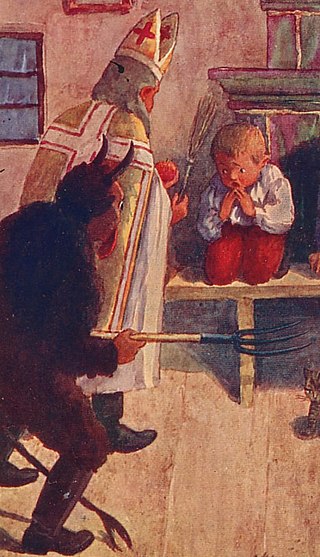
The Krampus is a horned anthropomorphic figure who, in the Central and Eastern Alpine folkloric tradition, is said to accompany Saint Nicholas on visits to children during the night of 5 December, immediately before the Feast of St. Nicholas on 6 December. In this tradition, Saint Nicholas rewards well-behaved children with small gifts, while Krampus punishes badly behaved ones with birch rods.

"Old Santeclaus with Much Delight" is an anonymous illustrated children's poem published in New York in 1821, predating by two years the first publication of "A Visit from St. Nicholas". It is the first publication to mention Santa Claus's reindeer and his sleigh, as well as being the first to describe his arrival on Christmas Eve. The accompanying illustrations are the earliest published artistic depictions of a Santa Claus figure.

Christmas traditions include a variety of customs, religious practices, rituals, and folklore associated with the celebration of Christmas. Many of these traditions vary by country or region, while others are practiced virtually identically worldwide.
